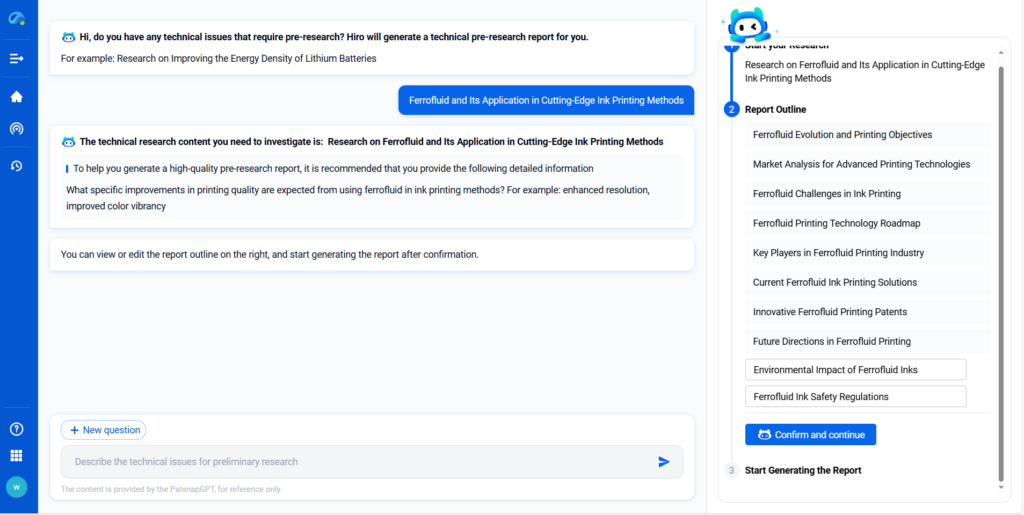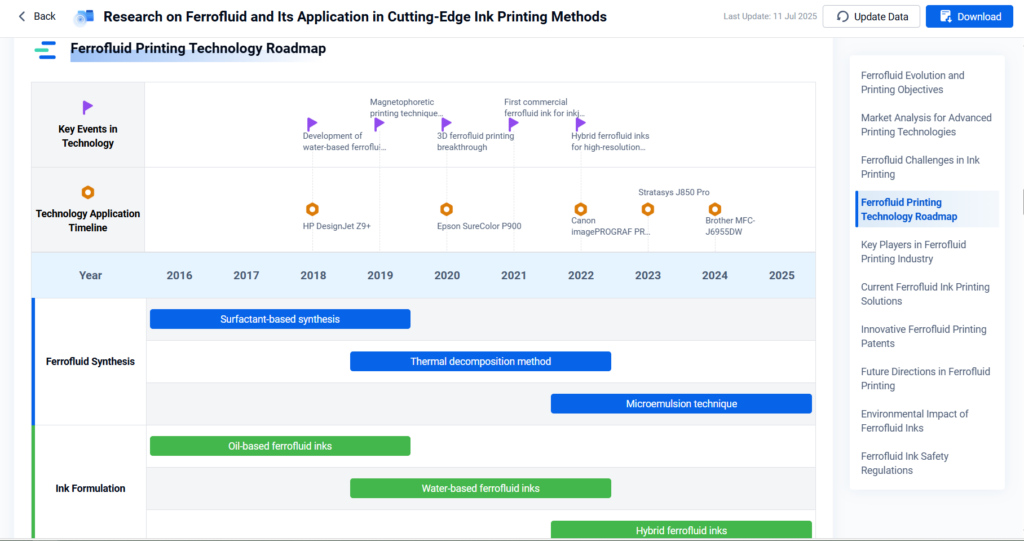
Introduction – What Is Ferrofluid and Why Should You Care?
Often described as a “magnetic liquid,” ferrofluid is a suspension of nanoscale magnetic particles in a carrier fluid, such as oil or water. When exposed to a magnetic field, it dramatically spikes and dances—an eye-catching visual that hints at its versatile scientific applications. Originally developed by NASA in the 1960s to manage fuel in zero gravity, ferrofluid has since evolved into a material of interest across robotics, medicine, energy, and electronics. So, why does this matter? Because ferrofluid sits at the intersection of magnetism, mobility, and material science—making it a key ingredient in the next generation of high-performance technologies.
This article offers a concise yet comprehensive breakdown of ferrofluid’s scientific basis, cross-industry applications, and future innovation potential. It also integrates insights powered by PatSnap Eureka AI Agent , highlighting technology directions, innovation hotspots, and global R&D collaborations. Through data-driven visualizations, readers can better understand how ferrofluid is shaping the next generation of materials science and engineering.
How Ferrofluid Works – Science in Motion
Ferrofluid operates on a simple yet powerful principle: it contains tiny magnetic particles, usually under 10 nanometers, coated with a surfactant to prevent clumping. These particles are suspended evenly in a fluid medium. When a magnetic field is applied, the particles align along the field lines, forming dynamic shapes and patterns. This responsive behavior enables the fluid to control heat, reduce friction, and manipulate motion in ways traditional materials cannot. It bridges the gap between solid-state magnetism and fluid dynamics.

Key Applications by Sector
To better understand the diverse capabilities of ferrofluid, we’ve organized its major application areas into six themed categories. This structure not only highlights the breadth of ongoing innovations but also makes it easier to explore targeted use cases in a science communication or blog format. To deepen this analysis, we leveraged PatSnap’s Eureka AI Agent—a powerful tool that analyzes thousands of global patents and trends across sectors.
Advanced Engineering & Industrial Design

Mechanical design is evolving—and ferrofluid is part of that transformation. With properties that enable precise magnetic control, heat dissipation, and surface interaction, ferrofluid is finding a home in high-stakes environments like aerospace, precision manufacturing, and next-gen coatings. Ferrofluid is revolutionizing mechanical systems. Its ability to dynamically respond to magnetic fields makes it ideal for enhancing heat management, reducing wear, and enabling precise actuation across complex industrial settings.
As interest in ferrofluid applications continues to grow, several key questions emerge: how exactly can this material be optimized and integrated into real-world systems? What challenges remain, and where are the most promising opportunities? Below, we explore some of the most pressing and innovative directions in ferrofluid-enhanced engineering:
- How to Harness Ferrofluid for Improved Heat Management?
- Ferrofluid Innovations Driving Reduced Friction in Mechanics
- How to Implement Ferrofluid in Aerospace Component Design?
- Ferrofluid’s Contribution to Low-Loss Magnetic Bearings
- How to Optimize Ferrofluid Properties for Nano-Coating Applications?
- Enhancing Ferrofluid Stability for Long-Term Industrial Use
- Ferrofluid’s Impact on Reducing Wear and Tear in Industrial Machinery
- Ferrofluid’s Contribution to Revolutionary Electromagnetic Research
- Exploring Ferrofluid’s Application in Dynamic System Designs
- How to Design Ferrofluid Systems for Improved Manufacturing Quality?
Medical & Biomedical Applications

From the inside of MRI machines to the frontier of nanomedicine, ferrofluid is unlocking smarter, safer, and more responsive medical technologies. Its ability to interact with magnetic fields at nanoscale levels opens doors for highly targeted interventions and diagnostic enhancements.Ferrofluid is paving the way for breakthroughs in targeted therapies and diagnostic precision. From contrast agents in MRI to nanomedicine, it offers unique magnetically responsive functionalities that improve both safety and efficacy.
As the healthcare sector increasingly embraces precision and personalization, ferrofluid stands out as a key enabler of next-generation medical innovation. The following key areas highlight how ferrofluid is reshaping the future of diagnostics, treatment, and biomedical engineering:
- Exploring Ferrofluid’s Role in Precision Medical Devices
- Exploring Ferrofluid’s Potential for Medical Drug Delivery
- How to Improve MRI Sensitivity with Ferrofluid Contrast Agents?
- How to Advance Nanomedicine with Ferrofluid Innovations?
- Ferrofluid’s Potential in Improving Biomedical Device Accuracy
- How to Advance Medical Technology with Ferrofluid Solutions?
- The Role of Ferrofluid in Advanced Medical Treatment Applications
- Implementing Ferrofluid Strategies in Healthcare Innovation Projects
- Exploring Ferrofluid’s Application in Precision Medical Techniques
Energy Systems & Environmental Engineering

As industries race toward carbon neutrality and resource efficiency, ferrofluid is emerging as a silent ally. Its unique thermomagnetic properties help optimize energy recovery, cooling processes, and waste management in ways conventional materials struggle to match. Ferrofluid contributes to greener technologies through its applications in renewable energy systems, heat recovery, and environmental remediation. Its magnetic and thermal properties align with sustainability goals in multiple sectors.
With the global shift toward sustainable engineering, ferrofluid is gaining attention across energy and environmental domains. Researchers and engineers are exploring diverse ways to integrate ferrofluid into eco-efficient systems. The following questions outline some of the most promising directions:
- Evaluating Ferrofluid’s Efficiency in Energy Harvesting Systems
- Future of Ferrofluid in Clean Energy Conversion Technologies
- How to Use Ferrofluid in Efficient Heat Exchanger Designs?
- How to Utilize Ferrofluid in Wireless Power Transfer Systems?
- Ferrofluid Innovations for Efficient Renewable Energy Solutions
- Ferrofluid’s Role in Reducing Marine Vessel Emissions
- How to Harness Ferrofluid in Reducing Carbon Footprint Operations?
- Ferrofluid’s Impact on Revolutionizing Industrial Water Treatment
- How to Implement Ferrofluid in Reducing Greenhouse Gas Emissions?
Electronics, Computing & Communication

In today’s fast-paced digital ecosystem, ferrofluid offers both miniaturization and performance gains. Whether enhancing data fidelity, acoustic engineering, or electromagnetic shielding, its tunable behavior meets the demands of modern electronics and information systems.In the digital age, ferrofluid plays a crucial role in enabling high-performance computing, acoustic precision, and secure communications. Its properties support miniaturization and efficiency in devices of the future.
As electronic systems evolve toward more intelligent, compact, and energy-efficient forms, ferrofluid is positioned to play a transformative role. The following explorations highlight how it is advancing cutting-edge applications across computing, signal processing, and interactive media:
- Future Trends: Ferrofluid in Next-Gen Display Technology
- How to Leverage Ferrofluid for Enhanced Data Storage Solutions?
- Exploring Ferrofluid’s Impact on Augmented Reality Devices
- Ferrofluid’s Role in Boosting Artificial Intelligence Processing Speeds
- How to Maximize Ferrofluid’s Efficiency in Quantum Computing Systems?
- Key Techniques for Ferrofluid Application in Acoustic Engineering
- How to Optimize Ferrofluid Characteristics for Acoustic Properties?
- Ferrofluid’s Contribution to Revolutionary Signal Processing Techniques
- Ferrofluid’s Role in Developing Secure Digital Infrastructure
Robotics, Automotive & Smart Mobility

Precision, responsiveness, and adaptability—these are hallmarks of next-gen mobility systems, and ferrofluid delivers on all three. From vibration control to intelligent damping in vehicles and robots, its integration marks a step forward in motion science.With real-time responsiveness and adaptive damping, ferrofluid is at the core of next-generation transport and robotic systems. It enhances motion control, safety, and system longevity in high-speed environments.
As mobility technologies evolve toward smarter, safer, and more efficient systems, ferrofluid is gaining traction as a vital enabling material. The following questions and directions illustrate how ferrofluid is transforming modern robotics, transportation, and motion-based engineering:
- Ferrofluid’s Impact on Advanced Robotics and Motion Control
- Ferrofluid Advancements in Automotive Shock Absorption Systems
- Exploring Ferrofluid’s Role in High-Speed Rail Systems
- How to Optimize Ferrofluid for Applications in Robotics?
- How to Improve Vehicle Safety with Ferrofluid Technologies?
- How to Implement Ferrofluid in Motion Control Systems?
- Exploring Ferrofluid’s Role in Emerging Transportation Technologies
- Ferrofluid’s Role in Advancing High-Precision Device Manufacturing
Emerging Fields & Cross-Disciplinary Innovation
When it comes to future-facing applications, ferrofluid is proving that functionality can also be imaginative. Whether it’s enabling shape-shifting textiles, supporting 3D printed structures, or powering space-age nanorobots, this fluid is flowing into the unexpected.Ferrofluid is pushing boundaries in creative and emerging sectors. From interactive textiles to nanorobotics and futuristic architecture, it enables design flexibility and performance not achievable with traditional materials.
As interdisciplinary innovation becomes the new engine of technological progress, ferrofluid is finding surprising applications across design, urban systems, and advanced manufacturing. The questions below explore how this versatile material is contributing to the next wave of hybrid science and engineering:
- The Role of Ferrofluid in Smart Textile Development
- Ferrofluid and Its Application in Cutting-Edge Ink Printing Methods
- Ferrofluid’s Potential in Advancing 3D Printing Capabilities
- Exploring Ferrofluid’s Application in Emerging Transportation Technologies
- How to Utilize Ferrofluid in Cutting-Edge Nanorobotic Designs?
- The Future of Ferrofluid in Smart Grid Technology
- Exploring Ferrofluid’s Potential in Efficient Wireless Technology Application
- Future Trends of Ferrofluid in Transformational Urban Development
- Ferrofluid Innovations in High-Precision Measurement Tools
What Makes Ferrofluid Unique? Advantages & Limitations
Ferrofluid’s key advantages include its responsiveness to magnetic fields, tunable viscosity, and adaptability to various environments. It excels where solid magnets or traditional fluids fall short, offering hybrid functionality. However, challenges remain: volatility at high temperatures, potential toxicity in biomedical contexts, and cost constraints in large-scale applications. These limitations are areas of active research and innovation.
The Future of Ferrofluid – Where Science Is Heading
As the push for sustainable and intelligent materials grows, ferrofluid stands out as a candidate for bio-compatible formulations, AI-integrated systems, and energy-efficient designs. Researchers are exploring biodegradable carriers, green synthesis methods, and multi-functional applications that go beyond magnetic response—including optical, thermal, and chemical tuning. The future may see ferrofluid as not just a helper in existing systems, but a foundational component in new technologies.
Conclusion – Why Ferrofluid Matters More Than Ever
Ferrofluid represents a compelling blend of physics and function. Its ability to transform in real time, respond to magnetic input, and integrate into diverse systems positions it as a material of the future. Whether in cancer treatment, next-gen cooling systems, or adaptive architecture, ferrofluid is helping industries rethink what liquid can do. For engineers, designers, and innovators, it’s not just a magnetic curiosity—it’s a toolkit for tomorrow.
Ready to Unlock the Future of Smart Materials with Ferrofluid?
PatSnap Eureka AI Agent. equips innovators with the tools to explore cutting-edge patent landscapes, uncover cross-disciplinary opportunities, and accelerate breakthroughs—whether you’re engineering next-gen cooling systems or developing magnetic-responsive medical devices.
👉 Book a Eureka demo today and turn ferrofluid potential into tangible product innovation.




